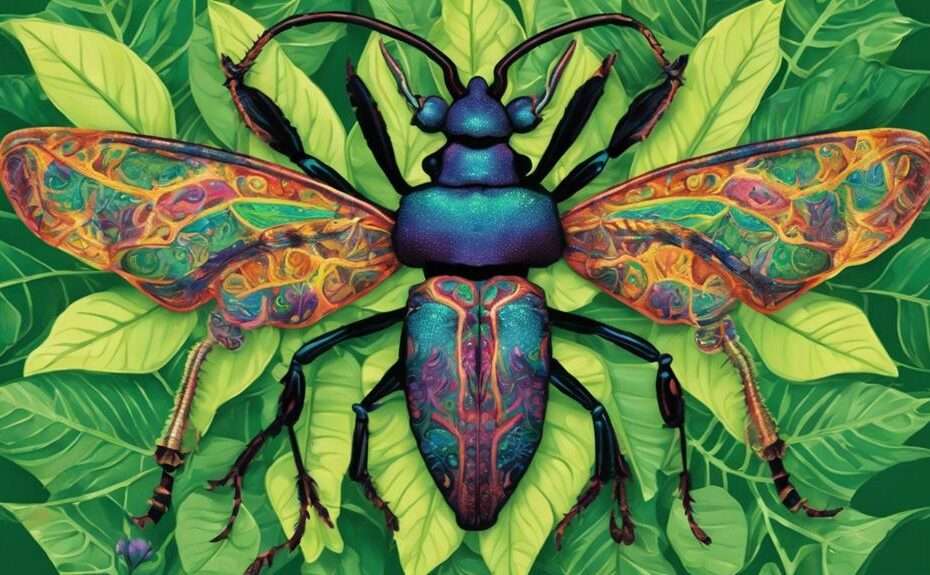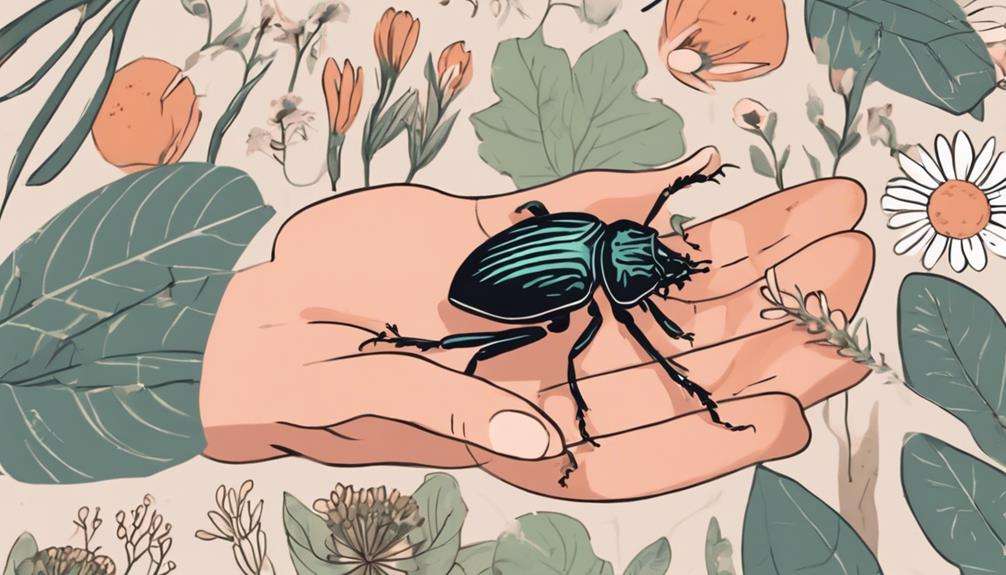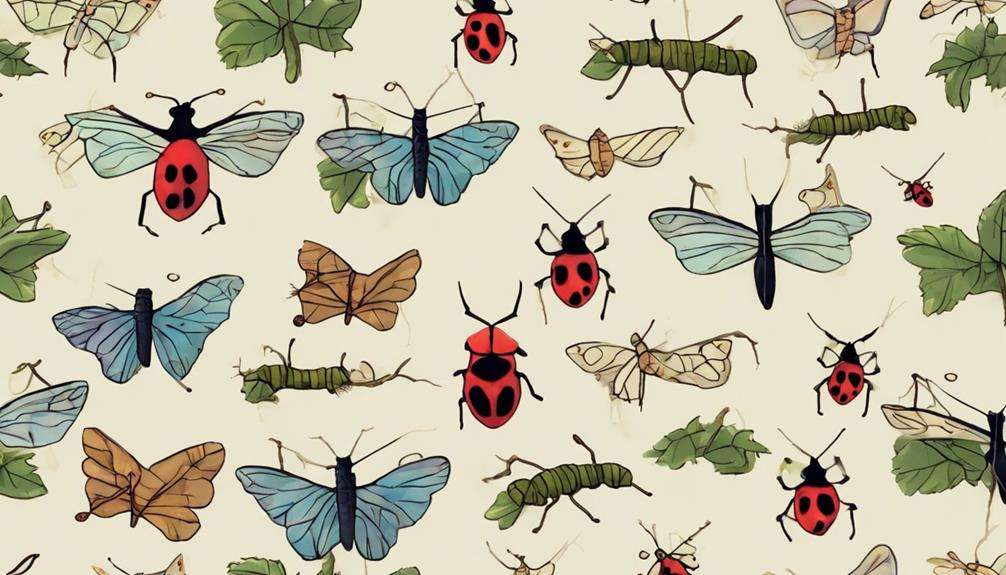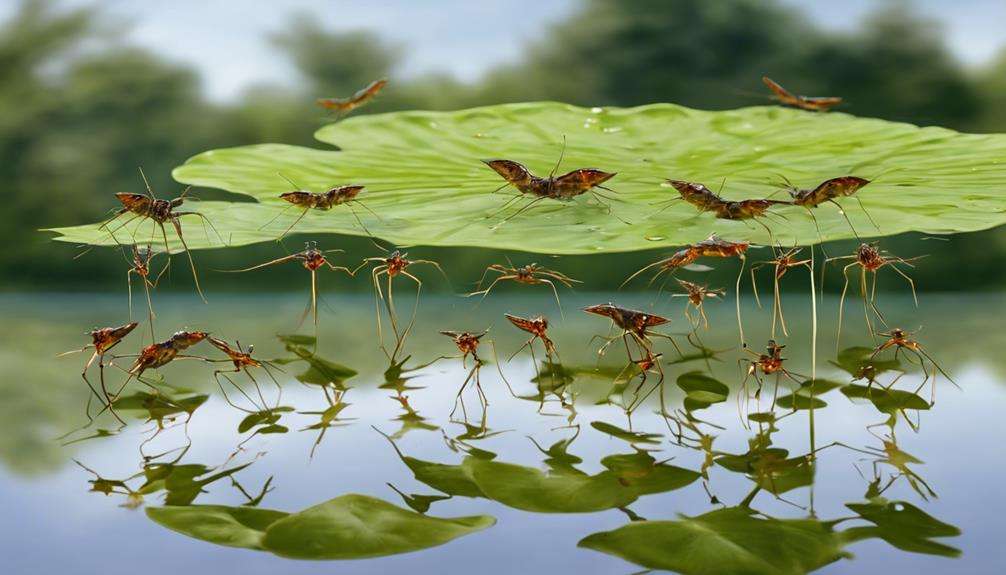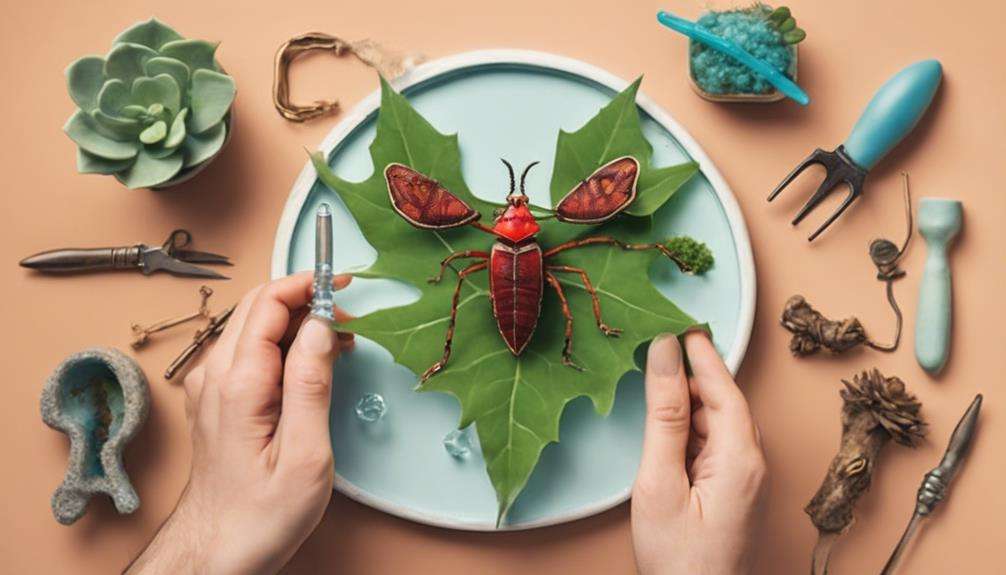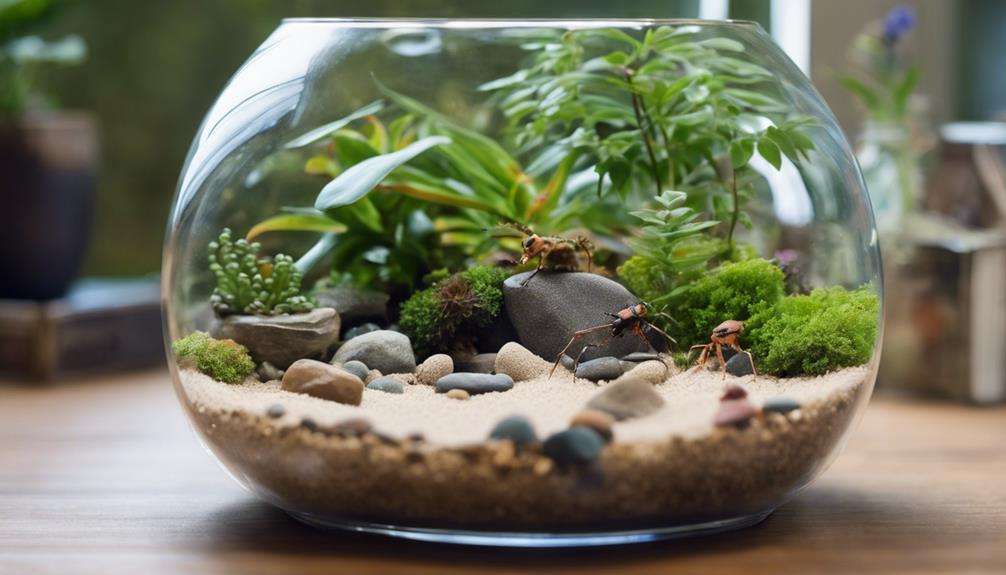Imagine stepping into the world of exotic pet ownership with a twist – welcoming Longhorn Beetles into your home. These intriguing creatures offer a glimpse into a unique kingdom of insect companionship, providing not just a visual delight but also a sense of wonder.
As you explore the kingdom of these quaint pets, you'll discover a kingdom of possibilities that might just surprise you.
Key Takeaways
- Unique care requirements vary for each Longhorn Beetle species.
- Longhorn Beetles boast diverse sizes, colors, and behavior patterns.
- Colorful Longhorn Beetles exhibit vibrant hues for defense or attraction.
- Understanding habitat preferences is crucial for successful Longhorn Beetle conservation.
Longhorn Beetle Species Overview
Longhorn beetles, with their distinctive long antennae and vibrant colors, are a fascinating group of insects belonging to the family Cerambycidae. As an exotic pet enthusiast, you may be intrigued to learn that there are over 20,000 species of longhorn beetles worldwide. Each species has its unique care requirements, making them an exciting choice for collectors. These beetles range in size, color patterns, and behavior, providing a diverse array of options for those interested in keeping them as pets.
When considering longhorn beetle species for captivity, it's essential to research their specific needs thoroughly. Some species may require specialized diets or habitat conditions to thrive in captivity. Understanding the natural behaviors and preferences of the chosen species is vital for providing appropriate care. Additionally, being aware of any regulations regarding the ownership of exotic insects is important to ensure both the well-being of the beetles and compliance with the law. Choosing the right longhorn beetle species that aligns with your capabilities and interests will enhance your experience as a beetle enthusiast.
Unique Characteristics of Longhorn Beetles
Longhorn beetles exhibit distinct features, including elongated bodies and long antennae that can exceed the length of their own bodies. These antennae serve important functions in environment sensing and mate location.
Additionally, the diverse range of sizes, colors, and patterns among longhorn beetles contributes to their visual allure as potential pets.
Distinct Longhorn Beetle Features
Featuring elongated antennae that often surpass their own bodies, these beetles exhibit a distinctive physical trait that sets them apart from other insect species.
Longhorn beetles, commonly considered as pet insects, showcase a remarkable diversity in colors and patterns, making them visually appealing to enthusiasts.
Some species of longhorn beetles engage in mimicry, imitating the appearance of wasps or bees to ward off potential predators effectively.
These beetles are also known for their wood-boring larvae, which play an important role in various ecosystems by breaking down decaying wood.
With a staggering number of over 35,000 species worldwide, longhorn beetles come in a wide range of sizes and shapes, offering a fascinating array of options for those interested in these unique insects.
Colorful Longhorn Beetle Species
With their vibrant hues and intricate patterns, the colorful longhorn beetle species captivate enthusiasts with their visually stunning appearances. Longhorn beetles exhibit a wide array of color patterns, ranging from metallic greens and blues to vivid reds and yellows.
These diverse species within the family Cerambycidae showcase unique combinations of colors, often serving as a defense mechanism or for attracting mates. Some longhorn beetle species mimic wasps or other insects to ward off predators.
Their larvae, known as wood borers, inhabit various types of wood during development, contributing to their role in forest ecosystems. The colorful nature of these beetles adds to their allure, making them not only fascinating pets but also aesthetically pleasing additions to any collection.
Longhorn Beetle Habitat Preferences
Inhabiting diverse ecosystems worldwide, longhorn beetles display unique habitat preferences that contribute greatly to their ecological roles. These beetles are commonly found in habitats abundant with dead wood, as their larvae rely on decaying wood as a primary food source. By aiding in the decomposition of wood, longhorn beetles play an essential role in ecosystem health.
Some species have evolved specialized mouthparts for feeding on pollen and nectar, showcasing their adaptability to different food sources. Additionally, certain longhorn beetle species have developed mimicry of wasps or bees as a defense mechanism against predators.
Understanding these habitat preferences is essential for conservation efforts aimed at protecting these fascinating insects. For more information, you can reach out to us via email at [email address].
Housing Requirements for Longhorn Beetles
To guarantee the well-being of your longhorn beetles, it's critical to provide a spacious terrarium that allows for climbing and flying.
Adequate ventilation is essential for maintaining proper air circulation within the enclosure, promoting a healthy environment for your exotic pets.
Monitoring and controlling temperature and humidity levels are essential aspects to contemplate for the best care of your longhorn beetles.
Suitable Beetle Habitats
Longhorn beetles thrive best in spacious terrariums furnished with branches, logs, and important ventilation to guarantee their comfort and well-being. To make sure your beetle habitat is suitable, keep the terrarium warm and humid, maintaining a temperature range of 75-85°F. Mimic their natural environment by providing a substrate of soft, decaying wood or sawdust to support their burrowing behavior.
Important ventilation is essential for air circulation within the terrarium. Regular misting helps maintain the required humidity level for longhorn beetles, ensuring they thrive in their new home. By creating a habitat that meets these criteria, you can provide your longhorn beetles with a comfortable and secure environment to live in.
Enclosure Size Guidelines
For best comfort and natural behavior expression, make sure that the enclosure size for your longhorn beetles is at least three times their body length in length, with ample vertical space for climbing structures and burrowing substrates.
When designing the enclosure, consider the space requirements necessary for these beetles to move freely and exhibit their natural behaviors. The vertical space should allow for climbing structures that mimic their natural habitat, enabling them to showcase their climbing abilities.
Additionally, providing a substrate depth of 2-3 times their body length is essential for longhorn beetles to burrow and lay eggs comfortably. To enhance their environment further, include natural elements like branches and bark for climbing and hiding, creating a more enriching space for your longhorn beetles.
Temperature and Humidity
Maintaining the appropriate temperature and humidity levels is vital for creating a suitable housing environment for longhorn beetles. Temperature regulation within the range of 75-85°F is essential for their best health and activity.
Humidity control is equally important, with levels ideally between 60-70% to simulate their natural habitat conditions.
When setting up the enclosure, focus on climate simulation by providing a well-ventilated terrarium with good airflow to guarantee the environmental conditions are met for the beetle's well-being. Avoid exposing the beetles to extreme temperature fluctuations and direct sunlight, as this can be harmful.
Regularly monitor and adjust the temperature and humidity levels to maintain a stable and comfortable habitat for your longhorn beetles.
Feeding Longhorn Beetles: Diet Tips
Feeding these xylophagous insects involves providing a varied diet that supports their health and longevity in captivity. Longhorn beetles exhibit feeding preferences that can range from specific types of wood to plant sap, depending on the species.
To meet their nutritional needs and assure dietary variety, consider offering a mix of hardwoods like oak, maple, or fruit tree branches. Some longhorn beetle species may also benefit from dietary supplements such as beetle jelly or specialized beetle feed available in pet stores.
Maintaining a balanced feeding schedule is essential, as overfeeding can lead to obesity and underfeeding can result in nutritional deficiencies. In addition to their primary wood-based diet, some longhorn beetles may consume fruits or nectar, adding further diversity to their nutritional intake.
Handling Longhorn Beetles Safely
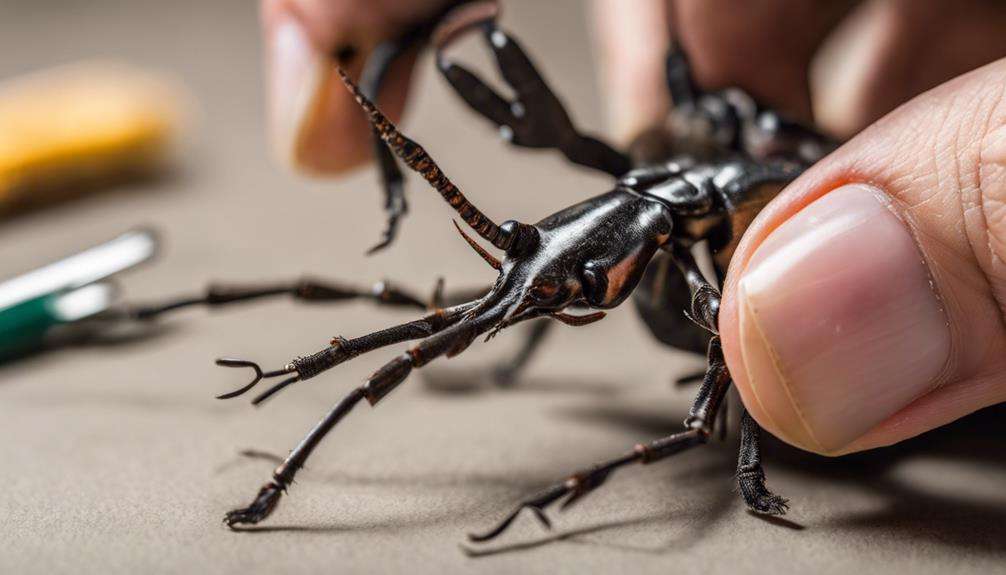
When handling Longhorn Beetles, it's important to exercise gentle care to protect their delicate bodies and antennae. These unique insects require delicate handling techniques to make sure their well-being. Using soft brushes or gentle tools can help you interact with Longhorn Beetles without causing any harm. It's essential to avoid holding them for extended periods as this can lead to stress and potential injuries. Instead, allow the Longhorn Beetles to walk on your hand or a safe surface, enabling you to observe their fascinating behavior without direct handling.
Observing the behavior of Longhorn Beetles can be a rewarding experience. By allowing them to move freely and explore their surroundings, you can gain valuable insights into their habits and preferences. Bonding with these creatures can also be a wonderful opportunity to establish a connection and appreciate their beauty up close. Remember always to wash your hands before and after handling Longhorn Beetles to maintain their health and hygiene.
Longhorn Beetle Health and Care Tips
To guarantee the prime health and well-being of Longhorn Beetles in captivity, creating a suitable environment with proper ventilation and nutrition is essential.
Longhorn beetles are prone to respiratory issues, so it's critical to provide a well-ventilated terrarium to make sure their respiratory health. Maintaining humidity levels is also important; regular misting of the terrarium helps achieve the required moisture levels.
When it comes to nutrition, offering a varied diet is key. Longhorn beetles thrive on a combination of fruits, vegetables, and beetle jelly to meet their nutritional requirements adequately.
Additionally, maintaining the terrarium temperature between 70-80°F is necessary for their overall well-being. Providing a substrate of hardwood mulch or rotting wood allows them to burrow and lay eggs comfortably.
Breeding Longhorn Beetles: What to Know
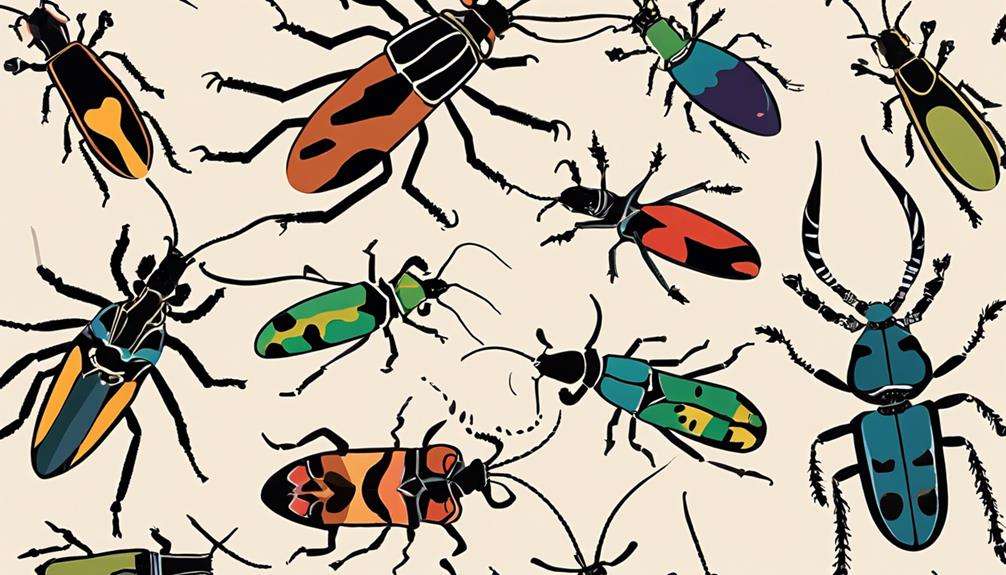
Creating an ideal breeding environment for Longhorn Beetles involves understanding their natural behaviors and environmental requirements to support successful reproduction. Longhorn beetles typically lay their eggs on or near host plants, ensuring that the larvae have immediate access to food upon hatching. This strategy is important for the survival of the offspring. The larvae of longhorn beetles develop inside wood, feeding on the inner tissues and creating intricate tunnels as they grow. Understanding this larval development process is essential for successful breeding.
When it comes to mating rituals, some longhorn beetle species have specific behaviors and pheromones that are important for attracting mates. Pheromone communication plays a significant role in ensuring successful reproduction among longhorn beetles. Breeding techniques for these exotic insects may require specialized knowledge of their preferred host plants and environmental conditions to mimic their natural habitat. By understanding their egg-laying strategies, larval development, mating rituals, and pheromone communication, you can create an environment conducive to the successful breeding of longhorn beetles.
Longhorn Beetles: Fun Facts and Trivia
Longhorn beetles, characterized by their remarkably long antennae, are a diverse group of insects with a global presence that spans over 35,000 identified species.
These beetles contribute importantly to ecosystem functions through their roles as decomposers and pollinators.
With their striking colors and patterns, some longhorn beetles aren't only fascinating to observe in the wild but also make visually appealing pets for enthusiasts.
Longhorn Beetle Behavior
With their strikingly long antennae that can surpass their own bodies in length, longhorn beetles exhibit a fascinating behavior that sets them apart in the insect world.
These extended antennae serve multiple purposes, including communication through pheromones to attract mates and detect potential predators.
Longhorn beetle larvae play an important role in ecosystem balance by decomposing dead trees, aiding in nutrient recycling.
In a clever act of predator defense, some longhorn beetle species mimic wasps, benefiting from the intimidating reputation of these stinging insects. This mimicry helps deter predators that might otherwise prey on these beetles.
Understanding these behaviors sheds light on the intricate survival strategies and ecological contributions of these intriguing insects.
Longhorn Beetle Habitats
What unique habitats do longhorn beetles inhabit, contributing to their essential role in forest ecosystems worldwide?
Longhorn beetles are versatile creatures, thriving in various environments such as forests, meadows, and gardens. In forests, they play an important role in decomposing decaying wood, aiding in nutrient recycling and supporting the ecosystem's health.
Their presence in gardens adds to the diversity of insect life, contributing to pollination and pest control. Within meadows, longhorn beetles can be found exploring the grassy expanses, utilizing the vegetation for shelter and food sources.
Their adaptability to different habitats showcases their ability to thrive in diverse settings, making them integral components of ecosystems worldwide. Through forest exploration, garden diversity, and meadow inhabitants, longhorn beetles demonstrate their resilience and importance in the natural world.
Longhorn Beetle FAQs Answered
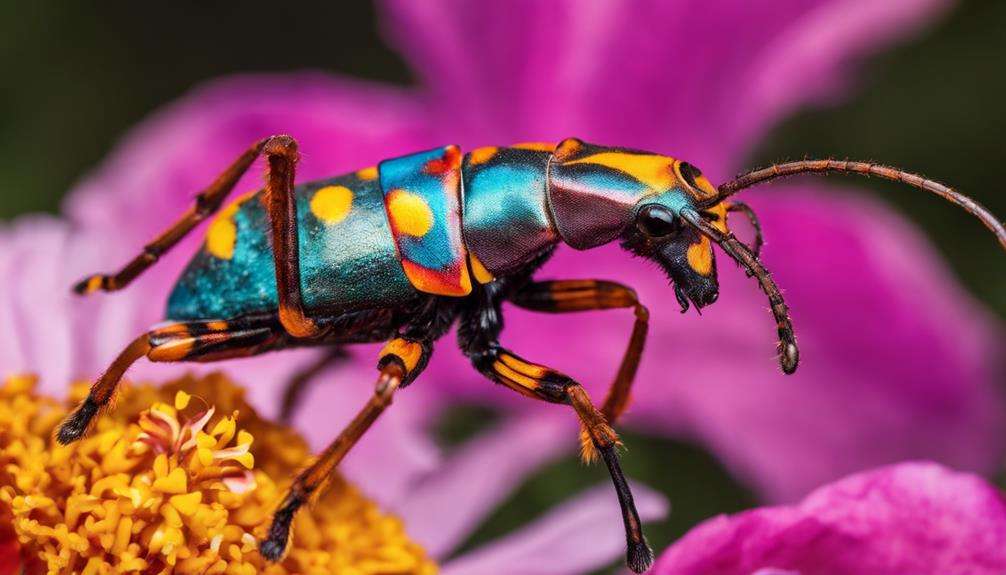
Exploring the fascinating world of Cerambycidae beetles reveals a plethora of intriguing facts about their unique characteristics and ecological significance. When it comes to beetle breeding, understanding the specific requirements of each species is vital. Longhorn beetles have varied breeding behaviors, with some laying eggs in crevices of wood while others prefer specific host plants. Providing a suitable environment with the right food source is essential for successful breeding outcomes.
For beetle handling, it's important to exercise caution due to their delicate nature. Longhorn beetles can be sensitive to rough handling, so gentle care is advisable to avoid causing harm. When it comes to beetle health, monitoring for signs of stress, illness, or parasites is key. Regular observation of behavior, feeding patterns, and overall appearance can help detect any health issues early on.
Longhorn Beetles as Educational Pets
Longhorn beetles, with their striking long antennae and enthralling behaviors, offer a unique opportunity for educational exploration and engagement. Beetle biology is a fascinating subject to explore when considering longhorn beetles as educational pets. These insects provide a hands-on approach to insect exploration, allowing for a closer look at their unique physical characteristics and life cycle stages. By observing the development of longhorn beetles from larvae to adult beetles, individuals can gain valuable insights into nature study and the interconnectedness of ecosystems.
Understanding the specific habitat requirements of longhorn beetles is essential when creating a suitable environment for them. This process involves learning about the types of wood they prefer for egg-laying and how to mimic natural conditions in captivity. Through this educational journey, one can appreciate the importance of biodiversity and the delicate balance within ecosystems. Longhorn beetles serve as not just pets but also as educational ambassadors for promoting conservation awareness and appreciation for the natural world.
Frequently Asked Questions
What Are the Best Beetles to Own as Pets?
For a fascinating pet choice, consider exotic beetle species. Guarantee proper care with a suitable habitat like a terrarium. Provide unique beetle habitats to mimic their natural environment, enhancing their well-being and your viewing pleasure.
Can Beetles Be Kept as Pets?
Yes, beetles can be kept as pets. They require specific care and maintenance. Understanding beetle behavior, providing suitable habitat and diet are essential. Different species have varying lifespans. Consider these aspects before owning beetles.
What Is the Best Bug to Have as a Pet?
When choosing a bug as a pet, consider unique companions like stick insects. They offer fascinating insect care routines and are excellent exotic pets. Their ability to blend in with their environment makes them a intriguing addition to your collection.
Are Longhorn Beetles Good or Bad?
Longhorn beetles are beneficial insects, not harmful to humans. They play a role in pollination and indicate ecosystem health. Some species are protected for biodiversity. They help in decomposition and nutrient cycling.
Conclusion
Thus, exotic longhorn beetles aren't only fascinating pets to contemplate, but also provide a unique and enchanting addition to any terrarium setup.
Their intricate patterns and striking colors make them a visually appealing choice for enthusiasts seeking something out of the ordinary.
With relatively easy care requirements, these beetles offer a low-maintenance yet quaint option for those looking to add a touch of novelty to their collection.
Consider welcoming these remarkable creatures into your home today.
